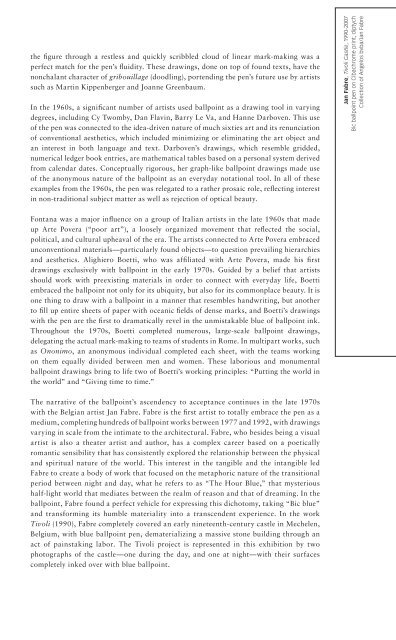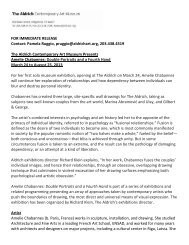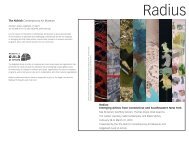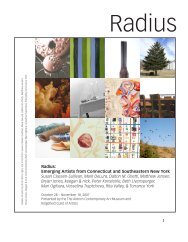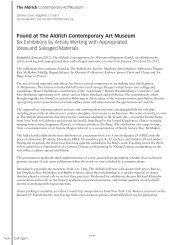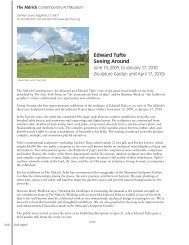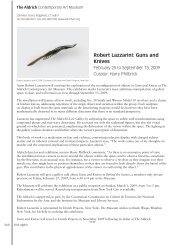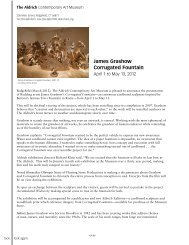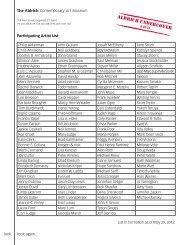Ballpoint Pen Drawing Since 1950 Rita Ackermann, Bill Adams ...
Ballpoint Pen Drawing Since 1950 Rita Ackermann, Bill Adams ...
Ballpoint Pen Drawing Since 1950 Rita Ackermann, Bill Adams ...
You also want an ePaper? Increase the reach of your titles
YUMPU automatically turns print PDFs into web optimized ePapers that Google loves.
the figure through a restless and quickly scribbled cloud of linear mark-making was a<br />
perfect match for the pen’s fluidity. These drawings, done on top of found texts, have the<br />
nonchalant character of gribouillage (doodling), portending the pen’s future use by artists<br />
such as Martin Kippenberger and Joanne Greenbaum.<br />
In the 1960s, a significant number of artists used ballpoint as a drawing tool in varying<br />
degrees, including Cy Twomby, Dan Flavin, Barry Le Va, and Hanne Darboven. This use<br />
of the pen was connected to the idea-driven nature of much sixties art and its renunciation<br />
of conventional aesthetics, which included minimizing or eliminating the art object and<br />
an interest in both language and text. Darboven’s drawings, which resemble gridded,<br />
numerical ledger book entries, are mathematical tables based on a personal system derived<br />
from calendar dates. Conceptually rigorous, her graph-like ballpoint drawings made use<br />
of the anonymous nature of the ballpoint as an everyday notational tool. In all of these<br />
examples from the 1960s, the pen was relegated to a rather prosaic role, reflecting interest<br />
in non-traditional subject matter as well as rejection of optical beauty.<br />
Jan Fabre, Tivoli Castle, 1990-2007<br />
Bic ballpoint pen on Cibachrome print, diptych<br />
Collection of Angelos bvba/Jan Fabre<br />
Fontana was a major influence on a group of Italian artists in the late 1960s that made<br />
up Arte Povera (“poor art”), a loosely organized movement that reflected the social,<br />
political, and cultural upheaval of the era. The artists connected to Arte Povera embraced<br />
unconventional materials—particularly found objects—to question prevailing hierarchies<br />
and aesthetics. Alighiero Boetti, who was affiliated with Arte Povera, made his first<br />
drawings exclusively with ballpoint in the early 1970s. Guided by a belief that artists<br />
should work with preexisting materials in order to connect with everyday life, Boetti<br />
embraced the ballpoint not only for its ubiquity, but also for its commonplace beauty. It is<br />
one thing to draw with a ballpoint in a manner that resembles handwriting, but another<br />
to fill up entire sheets of paper with oceanic fields of dense marks, and Boetti’s drawings<br />
with the pen are the first to dramatically revel in the unmistakable blue of ballpoint ink.<br />
Throughout the 1970s, Boetti completed numerous, large-scale ballpoint drawings,<br />
delegating the actual mark-making to teams of students in Rome. In multipart works, such<br />
as Ononimo, an anonymous individual completed each sheet, with the teams working<br />
on them equally divided between men and women. These laborious and monumental<br />
ballpoint drawings bring to life two of Boetti’s working principles: “Putting the world in<br />
the world” and “Giving time to time.”<br />
The narrative of the ballpoint’s ascendency to acceptance continues in the late 1970s<br />
with the Belgian artist Jan Fabre. Fabre is the first artist to totally embrace the pen as a<br />
medium, completing hundreds of ballpoint works between 1977 and 1992, with drawings<br />
varying in scale from the intimate to the architectural. Fabre, who besides being a visual<br />
artist is also a theater artist and author, has a complex career based on a poetically<br />
romantic sensibility that has consistently explored the relationship between the physical<br />
and spiritual nature of the world. This interest in the tangible and the intangible led<br />
Fabre to create a body of work that focused on the metaphoric nature of the transitional<br />
period between night and day, what he refers to as “The Hour Blue,” that mysterious<br />
half-light world that mediates between the realm of reason and that of dreaming. In the<br />
ballpoint, Fabre found a perfect vehicle for expressing this dichotomy, taking “Bic blue”<br />
and transforming its humble materiality into a transcendent experience. In the work<br />
Tivoli (1990), Fabre completely covered an early nineteenth-century castle in Mechelen,<br />
Belgium, with blue ballpoint pen, dematerializing a massive stone building through an<br />
act of painstaking labor. The Tivoli project is represented in this exhibition by two<br />
photographs of the castle—one during the day, and one at night—with their surfaces<br />
completely inked over with blue ballpoint.


